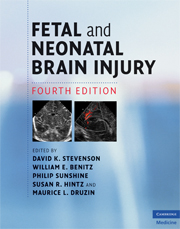Book contents
- Frontmatter
- Contents
- List of contributors
- Foreword
- Preface
- Section 1 Epidemiology, pathophysiology, and pathogenesis of fetal and neonatal brain injury
- Section 2 Pregnancy, labor, and delivery complications causing brain injury
- 5 Prematurity and complications of labor and delivery
- 6 Risks and complications of multiple gestations
- 7 Intrauterine growth restriction
- 8 Maternal diseases that affect fetal development
- 9 Obstetrical conditions and practices that affect the fetus and newborn
- 10 Fetal and neonatal injury as a consequence of maternal substance abuse
- 11 Hypertensive disorders of pregnancy
- 12 Complications of labor and delivery
- 13 Fetal response to asphyxia
- 14 Antepartum evaluation of fetal well-being
- 15 Intrapartum evaluation of the fetus
- Section 3 Diagnosis of the infant with brain injury
- Section 4 Specific conditions associated with fetal and neonatal brain injury
- Section 5 Management of the depressed or neurologically dysfunctional neonate
- Section 6 Assessing outcome of the brain-injured infant
- Index
- Plate section
- References
6 - Risks and complications of multiple gestations
from Section 2 - Pregnancy, labor, and delivery complications causing brain injury
Published online by Cambridge University Press: 12 January 2010
- Frontmatter
- Contents
- List of contributors
- Foreword
- Preface
- Section 1 Epidemiology, pathophysiology, and pathogenesis of fetal and neonatal brain injury
- Section 2 Pregnancy, labor, and delivery complications causing brain injury
- 5 Prematurity and complications of labor and delivery
- 6 Risks and complications of multiple gestations
- 7 Intrauterine growth restriction
- 8 Maternal diseases that affect fetal development
- 9 Obstetrical conditions and practices that affect the fetus and newborn
- 10 Fetal and neonatal injury as a consequence of maternal substance abuse
- 11 Hypertensive disorders of pregnancy
- 12 Complications of labor and delivery
- 13 Fetal response to asphyxia
- 14 Antepartum evaluation of fetal well-being
- 15 Intrapartum evaluation of the fetus
- Section 3 Diagnosis of the infant with brain injury
- Section 4 Specific conditions associated with fetal and neonatal brain injury
- Section 5 Management of the depressed or neurologically dysfunctional neonate
- Section 6 Assessing outcome of the brain-injured infant
- Index
- Plate section
- References
Summary
Introduction
In the United States in 2004, 3.4% of all births were multiple births. Between 1994 and 2004, the multiple birth ratio in the United States increased by 32% (from 2.6% to 3.4%), largely due to increased use of assisted reproductive technology. This increase in multiple birth rates has had a tremendous impact on prematurity. In 2004, one in eight babies (12.5% of live births) was born prematurely; and of multiple gestations, 61.4% were born preterm, 58.5% were low birthweight (less than 2500 g), and 11.5% were very low birthweight (less than 1500 g). Infants from multiple gestations thus carry a tremendous economic burden, in 2005 the annual cost of prematurity in the United States was well over $26 billion.
Among multiple gestations, the highest incidence is contributed by twins. Besides prematurity, twins, regardless of type, are at higher risk for neurological injury. Over the years, several studies have correlated cerebral palsy with multiple gestations. A recently published large case–control study based on the Swedish Medical Birth Registry between 1984 and 1998 showed a 1.4 odds ratio (95% CI 1.1–1.6) of cerebral palsy in twin gestations relative to their singleton counterparts.
Besides their effect on society, twins pose interesting and challenging diagnostic and management dilemmas. From conception to delivery, and even beyond, twin gestations behave remarkably differently from their singleton counterparts, and have a myriad of unique physiologic changes and pathologic conditions that one must consider when caring for these special pregnancies.
- Type
- Chapter
- Information
- Fetal and Neonatal Brain Injury , pp. 69 - 74Publisher: Cambridge University PressPrint publication year: 2009

